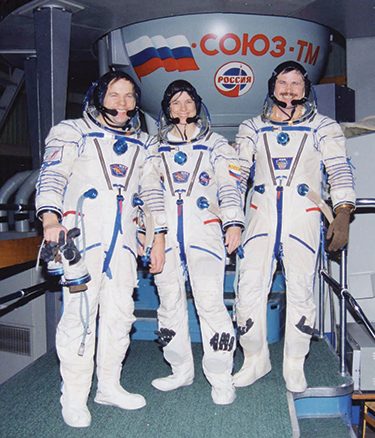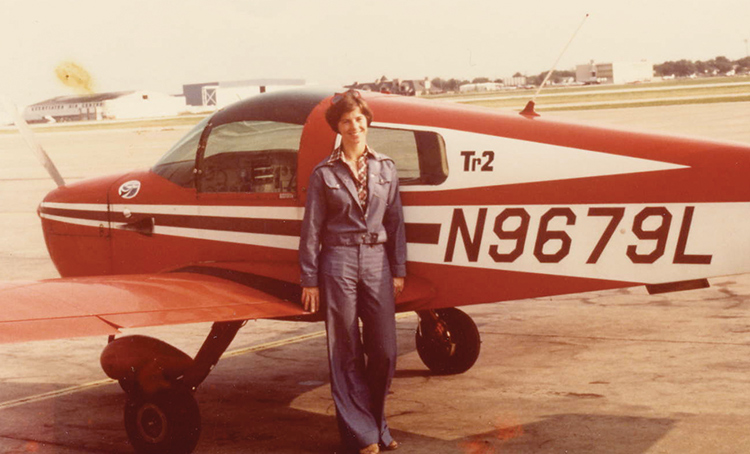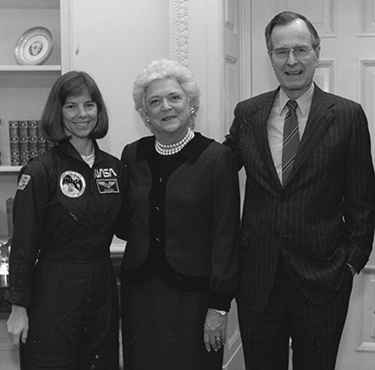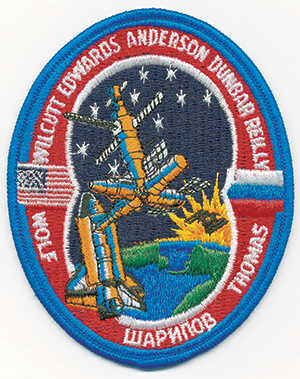At the age of 10, she was hit in the eye with a baseball but refused to come out of a game. When she enrolled in ceramic engineering at the University of Washington in 1967, some professors tried to talk her out of it because it was “not a field for women.”
When she first applied to be an astronaut, she was turned down.
Like that had any effect on Bonnie Jeanne Dunbar, ’71, ’75.
“I just don’t see obstacles,” Dunbar says matter-of-factly. “I see challenges. I like solving problems.”
So it’s no surprise that the young girl who grew up herding cattle and repairing fences on a 40-acre cattle and wheat ranch in the central Washington town of Sunnyside made good on the dream she had when she was 13. She indeed became an astronaut.
But not just any old astronaut. Dunbar is one of the most experienced female astronauts in the world, with 50 days in space covering 20.4 million miles in five space shuttle flights.

Bonnie Dunbar twice went to Russia to train for space shuttle flights that docked with the Russian Space Station Mir. Photo courtesy Bonnie Dunbar.
It was only fitting that Dunbar flew on the space shuttle. As an undergraduate at the UW, she helped Ceramic Engineering Professor James I. Mueller develop the special ceramic tiles that NASA would use to coat the space shuttle to make it able to withstand re-entry into the atmosphere.
She also played a major role in the production of the shuttle’s tile and thermal barrier coating, when, after earning her master’s degree in ceramic engineering from the UW, she went to work for Rockwell International and helped build the Columbia.
Her NASA career has touched several high points in the history of space travel. In 1979, she worked as a guidance and navigation officer and flight controller for the Skylab re-entry mission. (NASA hired her as a flight controller in 1978, two years before she was accepted into astronaut training.) In her first space flight, a mission onboard the Challenger in 1985 that was funded by the West German government, she became the first woman assigned to a laboratory mission to operate the Spacelab, its subsystems and experiments. In 1995, she flew in the first shuttle mission to dock with the Russian Space Station Mir. And in 1998, she flew in the last mission to deliver a U.S. astronaut to Mir. She also flew in both Challenger and Columbia before their tragic explosions.
Today, with five space flights behind her, she is NASA’s deputy director in the biological sciences and applications division of the Space and Life Sciences Directoriate. She is one of the few “technical” women in leadership positions within NASA, and though her flying career is probably over, she remains head over heels in love with her job.
Dunbar, the holder of many prestigious engineering, academic and space awards, has another one for her mantle: 2004 Alumna Summa Laude Dignata. Presented by the University of Washington and the UW Alumni Association, this honor recognizes her as the alumna of the year. Started in 1938, the award is the most prestigious honor the UW bestows upon its graduates.
How in the world did a young girl who grew up on a farm in the Yakima Valley and faced a steady stream of roadblocks—“No science for girls”—reach the top of her field?
“I grew up on a farm, and we didn’t have much money,” says Dunbar, whose family didn’t have indoor plumbing until she was a teen-ager. “Still, I always believed that I could do anything I wanted to as long as I worked for it.
“It was a message from both my grandparents and parents.”

Determined to fly in space, Dunbar earned her pilot’s license before she applied to be an astronaut in 1978 when NASA opened the astronaut corps to women. Photos courtesy Bonnie Dunbar.
She credits her father for her ambition and drive. He helped start a 4-H program when Dunbar was only 9, and he encouraged her to remain involved in the program throughout school. “She was just the common, ordinary girl,” Robert Dunbar says.
“When I went into engineering, being the only female was never unusual to me,” Dunbar says. “I had a lot of preparation for that in my youth, particularly with my involvement in the 4-H program.” There she learned a lot more than animal husbandry—it’s where she found out about responsibility and character development.
After Sunnyside High School—where she was a top student and was involved with sports, debate club, math club and cheerleading—she decided to attend the University of Washington. Deep down, she wanted to consider Caltech and MIT, since they were big-shot engineering schools, but Caltech was not coeducational at the time and MIT cost too much.

Bonnie Dunbar meets with Barbara Bush and President George H.W. Bush at the White House following Dunbar’s flight aboard the Columbia in January 1990. Photo courtesy Bonnie Dunbar.
Still, coming to the UW was a momentous occasion for Dunbar, since she was the first in her family to attend college. Her father, who fought in World War II, ran the family ranch, and her mother, one of nine children, couldn’t afford college.
At the UW, Dunbar, the oldest of four children, took her mission very seriously, often taking heavy loads of 18 credits or more, serving on the Engineering Student Council, playing for its baseball team, and serving as a volunteer for the coeducational auxiliary engineering program called Angel Flight. That was in addition to working as a waitress at the Greek Pastry Shop on the Ave and sometimes working at “U” District movie theaters.
When her first engineering professor at the UW told her class that half of the incoming freshman class wouldn’t make it because of the demanding curriculum, she didn’t cringe at all. “I loved the challenge,” she says. “I love working hard. It was fun.”
“She wanted to be an astronaut from the start,” says retired UW Ceramic Engineering Professor O.J. Whittemore. “She was a very good student and I knew she was going to be great. There was no stopping her.”
Irene Peden, a retired UW electrical engineering professor, met Dunbar when she was a freshman. “She was very determined,” Peden recalls. “She was upbeat, she stood up for herself, and knew what she believed in. You could also tell she was very smart.”
Dunbar’s big break at the UW was the chance to work with Mueller, a giant in the field of ceramic engineering. When other professors tried to dissuade her from studying ceramic engineering, Mueller encouraged her, introducing her to researchers working on the space shuttle tile project and other professors who could be of help to her.
After earning her bachelor’s degree in 1971, Dunbar took a job as a computer systems analyst at Boeing before returning to grad school at the UW to work again with Mueller. That led to work in London and later her job with Rockwell as a senior research engineer during production of the space shuttle tiles and thermal barrier material.

Dunbar’s uniform patch.
“I had my dream job,” Dunbar says. “I was solving production problems. I understood the tile, and I was given a tremendous amount of responsibility.”
She was honored as Rockwell’s Engineer of the Year in 1978. While the recognition was thrilling, when she heard that NASA had opened the astronaut program to women, Dunbar applied (she had earned her pilot’s license by then). She was a finalist but didn’t get in—only female candidates with M.D. or Ph.D. degrees were accepted. The rejection only served to motivate her, so she earned a Ph.D. in mechanical/biomedical engineering at the University of Houston. The next time she applied, in 1980, her dream came true when she was accepted as an astronaut candidate.
“I thought going into space would be one of the greatest things to do,” says Dunbar. With no television at home when she was a kid, she read H.G. Wells and Arthur Clarke, and spent time gazing at the clear night sky from her central Washington homestead. At 9 years of age, she watched the night sky for Sputnik, which gave her the bug to go into space.
In 1998, Dunbar went into space with another Husky, the late Michael Anderson, ’81. They flew on the space shuttle Endeavor on the eighth shuttle-Mir docking mission. Anderson was a mission specialist while Dunbar was the payload commander, responsible for all payload activities, including 23 science experiments. They were photographed proudly displaying a purple and gold flag from the UW they took onboard.
Dunbar has great memories of flying with Anderson, who died in the tragic disintegration of the shuttle Columbia in 2002. “It was such a big shock,” says Dunbar, who lost other friends and colleagues that day. “But I have no fear. Risks are just part of our business.”
Despite living in a Houston suburb and spending her time in space, training, doing research, traveling to give speeches or teaching at the University of Houston, Dunbar has kept remarkably close ties with the UW. She regularly comes to Seattle to speak at the UW, and continues to wow audiences everywhere she goes.
“I thoroughly enjoyed my UW experience,” Dunbar says. “Studying in Loew Hall, having hot chocolate at football games and working hard in engineering was so much fun. I just loved engineering. What a creative occupation. What you are doing is new and solving problems. What could be better than that?”
While she loves being an administrator at NASA—handling university research and affairs in the areas of outreach, managing university contracts, grants and collaborative agreements—she admits that she would return to space “in a heartbeat” if she got the chance. And she did say she is “thinking of building my own space station.” Don’t bet against her. You know what happens when people tell her no.